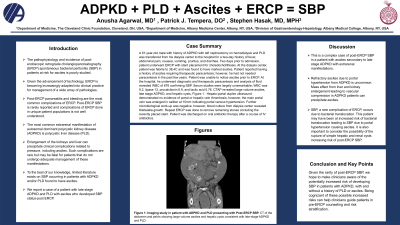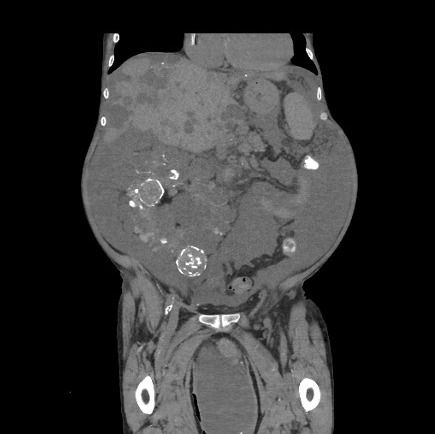Tuesday Poster Session
Category: Liver
P3954 - ADPKD Plus PLD Plus Ascites Plus ERCP Equals SBP
Tuesday, October 24, 2023
10:30 AM - 4:00 PM PT
Location: Exhibit Hall

Has Audio
- AA
Anusha Agarwal, MD
Albany Medical College
Albany, NY
Presenting Author(s)
Anusha Agarwal, MD1, Patrick Tempera, DO2, Stephen Hasak, MD, MPH1
1Albany Medical College, Albany, NY; 2Albany Medical Center, Albany, NY
Introduction: Pathophysiology and incidence of post-ERCP spontaneous bacterial peritonitis (SBP) in patients at risk for ascites is poorly studied. Additionally, to the best of our knowledge, limited literature exists on SBP occurring in patients with autosomal dominant polycystic kidney disease (ADPKD) and/or polycystic liver disease (PLD) found to have ascites. We report a case of a patient with late stage ADPKD and PLD with ascites who developed SBP status-post ERCP.
Case Description/Methods: A 61-year-old male with history of ADPKD with left nephrectomy on hemodialysis and PLD was transferred from his dialysis center to the hospital for a 2 day history of fever, abdominal pain, nausea, vomiting, pruritus, and diarrhea. Two days prior to admission, patient underwent ERCP with stent placement for choledocholithiasis. At the dialysis center, patient was febrile to 38.4C and was found to have marked ascites. Patient reported having a history of ascites requiring therapeutic paracentesis; however, he had not needed paracentesis in the past few years. The patient was unable to notice ascites prior to ERCP. At the hospital, he underwent diagnostic and therapeutic paracentesis and fluid analysis revealed WBC of 676 confirming SBP. WBC was 9.2, lipase 13, procalcitonin 6.9, and lactic acid 0.76. CTAP revealed large volume ascites, late stage ADPKD, and PLD, Figure 1. Hepato-portal duplex ultrasound demonstrated no evidence of portal or hepatic vein thrombosis; however, the main portal vein was enlarged in caliber at 15mm indicating portal venous hypertension. Further microbiological work-up was negative; however, blood culture from dialysis center revealed Klebsiella growth. Repeat ERCP was done to remove remaining stones occluding the recently placed stent. Patient was discharged on oral antibiotic therapy after a course of IV antibiotics.
Discussion: This is a complex case of post-ERCP SBP in a patient with ascites secondary to late stage ADPKD with extrarenal manifestations. SBP is typically a rare complication of ERCP and refractory ascites due to portal hypertension from ADPKD is uncommon. However, as seen in this patient, presence of non-cirrhotic portal hypertension leading to ascites may have resulted in increased risk of post-procedural SBP. As such, we hope to make clinicians aware of the potentially increased risk of developing SBP in patients with ADPKD, with and without a history of ascites. Being cognizant of these possible increased risks can help clinicians guide patients in pre-ERCP counseling.

Disclosures:
Anusha Agarwal, MD1, Patrick Tempera, DO2, Stephen Hasak, MD, MPH1. P3954 - ADPKD Plus PLD Plus Ascites Plus ERCP Equals SBP, ACG 2023 Annual Scientific Meeting Abstracts. Vancouver, BC, Canada: American College of Gastroenterology.
1Albany Medical College, Albany, NY; 2Albany Medical Center, Albany, NY
Introduction: Pathophysiology and incidence of post-ERCP spontaneous bacterial peritonitis (SBP) in patients at risk for ascites is poorly studied. Additionally, to the best of our knowledge, limited literature exists on SBP occurring in patients with autosomal dominant polycystic kidney disease (ADPKD) and/or polycystic liver disease (PLD) found to have ascites. We report a case of a patient with late stage ADPKD and PLD with ascites who developed SBP status-post ERCP.
Case Description/Methods: A 61-year-old male with history of ADPKD with left nephrectomy on hemodialysis and PLD was transferred from his dialysis center to the hospital for a 2 day history of fever, abdominal pain, nausea, vomiting, pruritus, and diarrhea. Two days prior to admission, patient underwent ERCP with stent placement for choledocholithiasis. At the dialysis center, patient was febrile to 38.4C and was found to have marked ascites. Patient reported having a history of ascites requiring therapeutic paracentesis; however, he had not needed paracentesis in the past few years. The patient was unable to notice ascites prior to ERCP. At the hospital, he underwent diagnostic and therapeutic paracentesis and fluid analysis revealed WBC of 676 confirming SBP. WBC was 9.2, lipase 13, procalcitonin 6.9, and lactic acid 0.76. CTAP revealed large volume ascites, late stage ADPKD, and PLD, Figure 1. Hepato-portal duplex ultrasound demonstrated no evidence of portal or hepatic vein thrombosis; however, the main portal vein was enlarged in caliber at 15mm indicating portal venous hypertension. Further microbiological work-up was negative; however, blood culture from dialysis center revealed Klebsiella growth. Repeat ERCP was done to remove remaining stones occluding the recently placed stent. Patient was discharged on oral antibiotic therapy after a course of IV antibiotics.
Discussion: This is a complex case of post-ERCP SBP in a patient with ascites secondary to late stage ADPKD with extrarenal manifestations. SBP is typically a rare complication of ERCP and refractory ascites due to portal hypertension from ADPKD is uncommon. However, as seen in this patient, presence of non-cirrhotic portal hypertension leading to ascites may have resulted in increased risk of post-procedural SBP. As such, we hope to make clinicians aware of the potentially increased risk of developing SBP in patients with ADPKD, with and without a history of ascites. Being cognizant of these possible increased risks can help clinicians guide patients in pre-ERCP counseling.

Figure: CT of the abdomen and pelvis showing right polycystic kidney, multiple liver cysts, and ascites.
Disclosures:
Anusha Agarwal indicated no relevant financial relationships.
Patrick Tempera indicated no relevant financial relationships.
Stephen Hasak indicated no relevant financial relationships.
Anusha Agarwal, MD1, Patrick Tempera, DO2, Stephen Hasak, MD, MPH1. P3954 - ADPKD Plus PLD Plus Ascites Plus ERCP Equals SBP, ACG 2023 Annual Scientific Meeting Abstracts. Vancouver, BC, Canada: American College of Gastroenterology.
